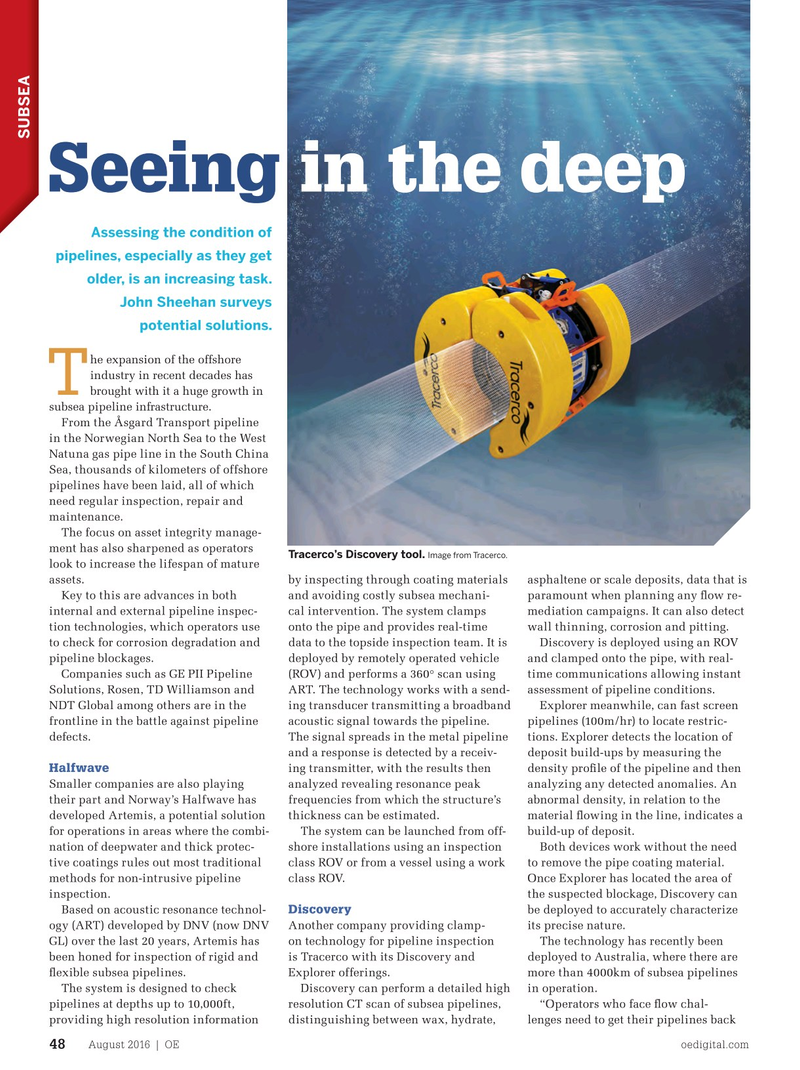
Page 46: of Offshore Engineer Magazine (Aug/Sep 2016)
Read this page in Pdf, Flash or Html5 edition of Aug/Sep 2016 Offshore Engineer Magazine
SUBSEA
Seeing in the deep
Assessing the condition of pipelines, especially as they get older, is an increasing task.
John Sheehan surveys potential solutions. he expansion of the offshore industry in recent decades has
T brought with it a huge growth in subsea pipeline infrastructure.
From the Åsgard Transport pipeline in the Norwegian North Sea to the West
Natuna gas pipe line in the South China
Sea, thousands of kilometers of offshore pipelines have been laid, all of which need regular inspection, repair and maintenance.
The focus on asset integrity manage- ment has also sharpened as operators
Tracerco’s Discovery tool. Image from Tracerco.
look to increase the lifespan of mature assets. by inspecting through coating materials asphaltene or scale deposits, data that is
Key to this are advances in both and avoiding costly subsea mechani- paramount when planning any ? ow re- internal and external pipeline inspec- cal intervention. The system clamps mediation campaigns. It can also detect tion technologies, which operators use onto the pipe and provides real-time wall thinning, corrosion and pitting.
to check for corrosion degradation and data to the topside inspection team. It is Discovery is deployed using an ROV pipeline blockages. deployed by remotely operated vehicle and clamped onto the pipe, with real-
Companies such as GE PII Pipeline (ROV) and performs a 360° scan using time communications allowing instant
Solutions, Rosen, TD Williamson and ART. The technology works with a send- assessment of pipeline conditions.
NDT Global among others are in the ing transducer transmitting a broadband Explorer meanwhile, can fast screen frontline in the battle against pipeline acoustic signal towards the pipeline. pipelines (100m/hr) to locate restric- defects. The signal spreads in the metal pipeline tions. Explorer detects the location of and a response is detected by a receiv- deposit build-ups by measuring the
Halfwave ing transmitter, with the results then density pro? le of the pipeline and then
Smaller companies are also playing analyzed revealing resonance peak analyzing any detected anomalies. An their part and Norway’s Halfwave has frequencies from which the structure’s abnormal density, in relation to the developed Artemis, a potential solution thickness can be estimated. material ? owing in the line, indicates a for operations in areas where the combi- The system can be launched from off- build-up of deposit. nation of deepwater and thick protec- shore installations using an inspection Both devices work without the need tive coatings rules out most traditional class ROV or from a vessel using a work to remove the pipe coating material. methods for non-intrusive pipeline class ROV. Once Explorer has located the area of inspection. the suspected blockage, Discovery can
Discovery
Based on acoustic resonance technol- be deployed to accurately characterize ogy (ART) developed by DNV (now DNV Another company providing clamp- its precise nature.
GL) over the last 20 years, Artemis has on technology for pipeline inspection The technology has recently been been honed for inspection of rigid and is Tracerco with its Discovery and deployed to Australia, where there are ? exible subsea pipelines. Explorer offerings. more than 4000km of subsea pipelines
The system is designed to check Discovery can perform a detailed high in operation.
pipelines at depths up to 10,000ft, resolution CT scan of subsea pipelines, “Operators who face ? ow chal- providing high resolution information distinguishing between wax, hydrate, lenges need to get their pipelines back
August 2016 | OE oedigital.com 48 048_OE0816_Subsea5_pipeline inspection.indd 48 7/24/16 9:26 AM

 45
45

 47
47